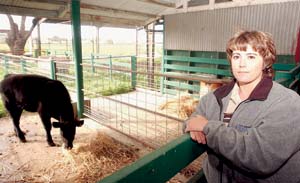
Four different leaders in four years.
For a program rich in tradition, once the pride of San Benito
High, the prospects were far from uplifting.
Four different leaders in four years.
For a program rich in tradition, once the pride of San Benito High, the prospects were far from uplifting.
But the regression, it seems, has halted. With this school year’s hire of instructor Kelly Bianchi, bringing a long-missed charisma and promise for stability, many observers believe the high school’s agriculture program is on the rise again.
Bianchi, raised on a livestock ranch in Oakdale and most recently the head of Morgan Hill’s ag department, says she’s here to stay.
That, for students and parents, many who lived through generations of steady prominence, is an enlightening notion.
Bianchi, 32, has energized the high school department and, with it, the coinciding Hollister chapter of Future Farmers of America (FFA).
“I feel like she’s been our teacher for 10 years,” said Roger Pereira, a sophomore, during Friday’s tri-tip barbecue fund-raiser at lunchtime.
The barbecue was one part of FFA Week for Hollister’s and other FFA programs throughout the nation. It is celebrated each year the week of George Washington’s birthday.
But the outdoor chow down was a lesser of the animated events throughout the week.
There was an arm-wrestling competition. There were “tub races,” in which three students piled in a wheeled container and maneuvered – two pushing with poles and one steering – through an obstacle course. And a tradition continued that dates back to the 1950s – the Barn Dance on Friday night.
Although the dance was held in a gym, the high school does actually maintain a barn, a structure built in 1959 by FFA students.
It’s that seemingly distant era – during the 21-year tenure of former educator turned legend Gordon Tibbs – which Bianchi refers to as “the hay day” for local FFA.
Last year, Tibbs was inducted into the California Agricultural Teachers Association Hall of Fame.
Bianchi fervently wants to build the program again. When Tibbs was at the helm, there were four or five staff members, she said. Now Bianchi runs it solo, with an immediate goal of expanding enrollment so there’s a need for another ag instructor.
On the subject of history, she remains realistic: “We won’t be where it used to be in the hay day.” But at least she has something to shoot for, and coming a tad short wouldn’t disappoint anyone around here.
Tibbs, meanwhile, isn’t Bianchi’s only model of inspiration. It was during her time in Oakdale as a student that her passion for agriculture education sprouted.
She looked up to Oakdale’s instructor Don Hendricks, she said, “the way he made agriculture fun and interesting.” Mr. Hendricks instilled in her, she said, responsibility, dedication and an outgoing persona.
Bianchi wants to have the same influence on Hollister students. She believes her ability to relate to the FFA kids – and her outward devotion to the subject – has put her on that path.
“Agriculture is something I know and like,” Bianchi said, “and love.”
After high school, she attended Modesto Junior College and Fresno State University, where she majored in agriculture education.
She directed Live Oak’s program the past eight years. There, she met some of Hollister’s current students, she said, as the two schools compete against each other – along with Gilroy and Campbell – in the Santa Clara Section.
“When she came here, she just fit right in,” said senior Kyle Valent.
He said it was difficult adjusting in previous years to the revolving door of instructors, which students and parents say fostered a sense of instability in the program.
Valent’s mother, Frankie, is in her second year as the FFA booster club president.
“We’re thrilled to death to have her,” she said during Friday’s barbecue. “We finally have a teacher that’s here to stay.”
Of the 81 students in the program, four were recent sectional winners of “proficiency awards” in such subjects as agriculture mechanics and dairy production. Two then won at the regional level and are now awaiting word whether they’ll reach the state finals.
But there’s more to FFA than competition. Students hold meetings once a month. As do boosters, who raise money to fund field trips, convention costs, scholarships and other aspects of the program.
And there’s the annual County Fair, where 40 students took part in 2003. Right off the bat, being in October, it allowed students, Bianchi said, a chance “to learn my expectations.”
To be more precise, her high expectations.
Bianchi stresses academics, she said, because standards for college entrance have heightened.
“If they don’t do well in school, they don’t take part in other activities.”
Of the improvements Bianchi anticipates, she hopes for more resources – such as additions to the barn arena, which could be funded through a pending grant, she said.
And she wants more kids in FFA – and not just country kids.
San Benito High, she realizes, is highly diverse, both ethnically and socially. And although a few FFA kids come from city families, she wants more.
There’s a flawed expectation at most ag schools, she said, a challenge to overcome.
“A lot of chapters get that stigma you have to be a hick to be in FFA,” Bianchi said. “I’m trying to get rid of that image. You can be anybody and be a part of this.
“You just have to be interested in agriculture.”









